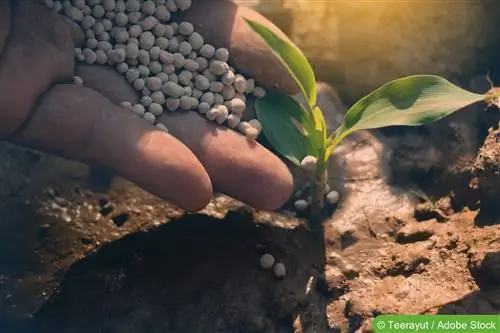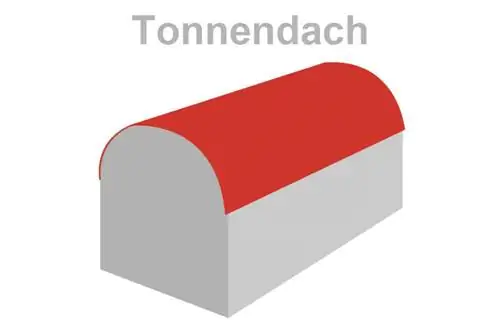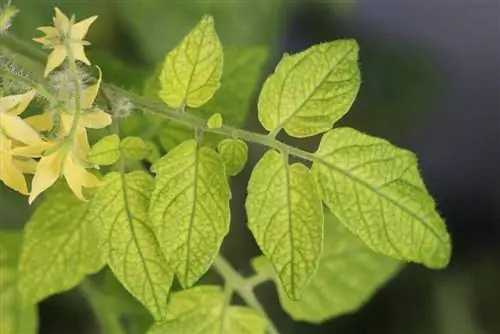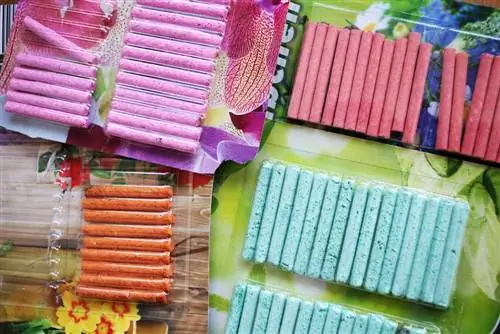- Author admin [email protected].
- Public 2023-12-17 03:39.
- Last modified 2025-01-24 12:45.
Do the colors of young leaves on ornamental and crop plants fade, do the foliage sprout in a stunted form, do the harvest yields leave something to be desired, as does the taste? Then there is a lack of sulfur. Although the natural element is present in humus in sufficient quantities, it is only available to plants when diligent bacteria convert it into sulfate. In addition to the regular nutrient supply, the administration of sulfur fertilizer makes sense in the event of deficiency symptoms in order to remedy short-term growth deficits. Find out everything you need to know about the composition, explore the advantages and benefit from an overview of the prices.
Composition
Since sulfur is not the only main nutrient and significantly improves the ability of plants to absorb nitrogen, commercially available sulfur fertilizers are always a combination of 2 or more elements. Sulfur is usually present as a water-soluble sulfate. This makes sense, since in elemental form, with a proportion of up to 90 percent, it is only available to plants very slowly. When it comes to the availability of sulfur, it is irrelevant whether it is magnesium, potassium or ammonium sulfate. The suffering plants definitely get the sulfur they need. You can't go wrong when choosing suitable fertilizers. The following overview shows the proportion of sulfur in the composition of proven fertilizers:
- Sulfuric ammonia: 24%
- Kieserite: 20%
- Potassium sulfate: 18%
- Plaster: 18%
- Kalimagnesia: 17%
- Ammonium sulfate s altpeter (ASS): 13%
- Entec26: 13%
- Superphosphate: 12%
- AHL + Sulfur: 6%
- Thomaskali: 4%
Manure and manure contain between 7 and 10 percent sulfur. It should be taken into account that the nutrients in organic fertilizer must first be broken down by microorganisms in order to be available to the plants. This process takes weeks or even months; a time that attacked ornamental and useful plants do not have. The immediate availability of the nutrient can only be guaranteed in water-soluble, mineralized form as sulfate.
Tip:
An acute sulfur deficiency can be resolved with Epsom s alt sprays. 10 kg of Epsom s alt in 200 liters of water produces around 1.5 to 2 kg of sulfur to cover the most necessary needs in the short term. Subsequent application of sulfur-containing fertilizers and preventive autumn fertilization round off the temporary help with long-term measures.
Advantages
Until the 1970s and 1980s, assessing the sulfur requirement for plant supply was not on the agenda of prudent hobby gardeners and commercial farmers. At that time, between 50 and 100 kg of sulfur per hectare reached the plants each year via acid rain. As part of targeted environmental protection measures using flue gas desulfurization plants, the sulfur content in rain was reduced to less than 10 kg per hectare, with a continuing downward trend. As a result, a lack of sulfur is now one of the most common nutritional disorders in the cultivation of ornamental and useful plants. The use of mineral sulfur fertilizer therefore results in the following advantages:
- Short-term availability thanks to sulfur content in the form of water-soluble sulfate
- Rapid compensation of deficiency symptoms, such as leaf chlorosis and stunted growth
- Optimized absorption capacity of vital nitrogen
- Has a strengthening effect on cell membranes and repels pest damage
- Stabilization and increase of protein content to improve crop yield, while reducing nitrate
The Bavarian State Institute for Agriculture in Freising wanted to know exactly and carried out a direct comparison as part of a three-year field test. At the same time, work was carried out at 5 different locations with mineral sulfur fertilizer in the form of ammonium sulfate s altpeter (ASS), lime ammonium s altpeter (KAS) without sulfur and elemental sulfur. The result was convincing. The administration of ASS improved the yield compared to KAS by a whopping 5 tons, while the administration of organic sulfur fertilizer even led to a reduced yield.
Prices
In commercial agriculture, the assessment of suitable sulfur fertilizers is not based solely on price. Rather, other factors need to be taken into account, such as the fertilizer system used. In the hobby garden, on the other hand, costs play a major role in the purchasing decision. As practice has shown, the specific nutrient combination in the fertilizer has no influence on the actual effect of the sulfur. If there is no soil analysis that explicitly indicates an acute deficiency of other nutrients, such as magnesium or potassium, and requires an adequate fertilizer, the following preparations are suitable for use in private ornamental and kitchen gardens:
- Sulfuric ammonia (SSA): 1.60 euros per kg - from 25 kg purchase: 0.52 euros per kg
- Ammonium sulfate s altpeter (ASS): 2.50 euros per kg - from 25 kg purchase: 1.20 euros per kg
- Potassium sulfate (KAS) with sulfur: 17, 20 to 29, 50 euros per kg
- Gypsum, natural gypsum: 1.49 euros per kg
- Kalimagnesia (patent potash): 3.40 euros per kg - from 25 kg purchase: 1.36 euros per kg
- Superphosphate: 3.39 euros per kg - from 25 kg purchase: 1.20 euros per kg
- Ammonium nitrate-urea solution (AHL): 7.60 euros per l - from 50 l purchase: 1.68 euros per l
- Epsom s alt: 1.21 euros per kg - from 25 kg purchase: 0.80 euros per kg
- Thomaskali: 1.57 euros per kg - from 25 kg purchase: 0.92 euros per kg
- Schacht sulfur fertilizer with 80% elemental sulfur: 4.82 euros per 100 g
Apart from the sometimes considerable price differences, several of the sulfur fertilizers listed here can only be discovered in specialist retailers. If the deficiencies explained above become apparent, simply using common sulfur fertilizers such as patent potash, superphosphate or Thomaspotash can solve the problem without much hassle.
Tip:
The administration of sulfur fertilizer always has a lowering effect on the pH value in the soil. This side effect may be desirable or not beneficial for lime-loving plants. Therefore, parallel to sulfur fertilization, the pH value should be checked regularly using an uncomplicated test set from the garden center.
Do not confuse symptoms with nitrogen deficiency
The signs of a lack of sulfur are similar to those of a lack of nitrogen. Deducing the need for sulfur fertilization based solely on fading leaves can be futile. It also depends on which leaves the symptoms appear on. We have put together the most important indicators and distinguishing features between nitrogen and sulfur deficiency here:
Sulfur deficit
- In the young leaves, the leaf veins lighten first in the early stages
- As the progress progresses, the young leaves continue to fade
- New shoots only thrive with narrow leaves
- The older leaves initially retain their deep green color
While legumes yellow and die very quickly as a whole, the process on other ornamental and useful plants is a little slower. As a result, the plants cannot survive the lack of sulfur because they are missing a main nutrient. The outstanding indication of this is that it is generally the young leaves that are affected first. The older foliage follows some time later.
Tip:
If you are in doubt as to whether it is a lack of sulfur or nitrogen, a professional soil analysis will provide reliable information. The soil samples taken by hand are sent by post to a special laboratory. After the evaluation, you will receive a specific result including a fertilizer recommendation.
Lack of nitrogen
- The older leaves lose their rich green color and lighten
- The leaf tips turn brown
- The color on the leaf stalk continues to lighten
- The roots gradually become almost white
Lack of nitrogen is clearly visible in leafy vegetables, such as cabbage, because here the discoloration continues into a reddish-purple. The shoots on roses become increasingly thinner and weaker. The pale yellow foliage is covered with small, red spots. Boxwood experiences a similar situation when it lacks nitrogen. The evergreen, older leaves lose their intense color and lighten. Since the young foliage is not affected, the uniform coloring of the ornamental tree is lost.
Conclusion
The days when sulfur fertilizer fell from the sky in the form of 'acid rain' are long gone. The extensive environmental protection measures are bearing fruit for the benefit of all of us. Despite this, ornamental and crop plants are increasingly suffering from a sulfur deficiency. Where the young leaves turn pale yellow and the harvest yield and taste of fruit or vegetables leave something to be desired, quick-acting sulfur fertilizers are available. The wide range offers preparations with different sulfur concentrations and significantly fluctuating prices for you. It's good to know that the plants don't care how the sulfur gets into their veins, as long as it is available as water-soluble sulfate. Instead of investing in a cost-intensive special fertilizer, inexpensive preparations such as patent potash, superphosphate, Epsom s alt or Thomas potash resolve the acute deficiency.






